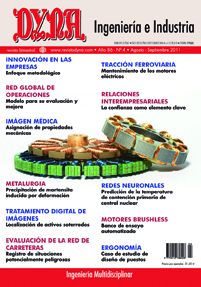LOCATION AND IDENTIFICACION OF BURIED ASSETS BY MEANS OF GEORADAR AND IMAGE PROCESSING
Keywords:
Procesamiento de imagen, reconocimiento de patrones, visión artificial, clasificadoresAbstract
There is a growing industrial interest, covering from the sector of Engineering to the Environmental Management, among others, in the location of assets and anomalies in the subsoil in an efficient way and with a reduced error rate. It is aimed to increase the security and precision in the inspection of the subsoil by means of non-invasive and fast methods that could replace more traditional methods of direct digging.Nowadays, there is a wide range of sensors that can be used. One of them is the georadar, Ground Penetrating Radar, from now on GPR, used in many different disciplines such as archaeology, hydrology, forensics, engineering and civil engineering, among others. The geophysical prospection with GPR is a technology capable of solving the problem inherent to the knowledge of the subsoil. It allows characterising perfectly the subsoil and the structures inside, in an efficient and accurate way, with a minimum impact. As long as the technology goes forward, in many aspects of our life, it is possible to accomplish several tasks in a fast, efficient and automated way. Image processing has consolidated as a reliable technology installed in a wide number of applications for different problems. The high accuracy and resolution of the actual cameras, aslong as with the fast communication protocols and the services of the computers make possible to solve difficult problems, usually hand-crafted in the near past.In this article, we present an image processing application whose aim is to locate and identify the buried assets that can be found in a subsoil survey. Therefore, image processing techniques are applied to interpret the electromagnetic signals coming from georadar.First, the problem to be solved is shown, and some of the approaches to the problem are enumerated, which have been tackled during last years. Next, the proposed solution is thoroughly detailed together with their constituting elements, also the obtained results and the conclusions extracted from this work are exposed.Downloads
Published
2011-07-28
Issue
Section
ARTICULOS

